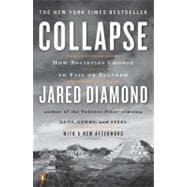In his runaway bestseller Guns, Germs, and Steel, Jared Diamond brilliantly examined the circumstances that allowed Western civilizations to dominate much of the world. Now he probes the other side of the equation: What caused some of the great civilizations of the past to fall into ruin, and what can we learn from their fates? Using a vast historical and geographical perspective ranging from Easter Island and the Maya to Viking Greenland and modern Montana, Diamond traces a fundamental pattern of environmental catastrophe—one whose warning signs can be seen in our modern world and that we ignore at our peril. Blending the most recent scientific advances into a narrative that is impossible to put down, Collapse exposes the deepest mysteries of the past even as it offers hope for the future.
“Diamond’s most influential gift may be his ability to write about geopolitical and environmental systems in ways that don’t just educate and provoke, but entertain.” -The Seattle Times
“Extremely persuasive . . . replete with fascinating stories, a treasure trove of historical anecdotes and haunting statistics.” -The Boston Globe
“Extraordinary in erudition and originality, compelling in its ability to relate the digitized pandemonium of the present to the hushed agrarian sunrises of the far past.” -The New York Times Book Review








